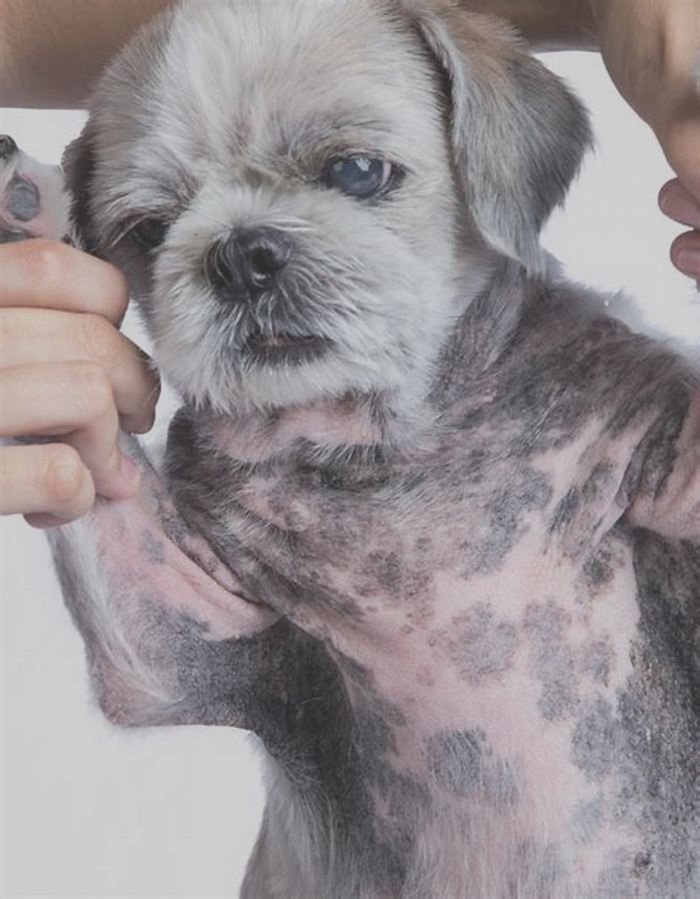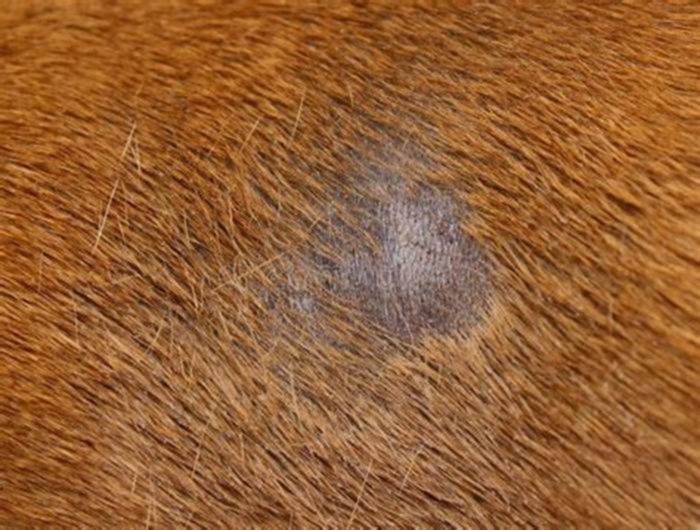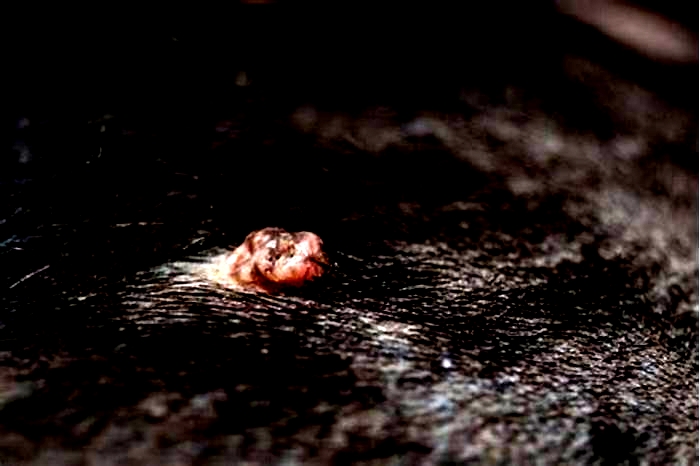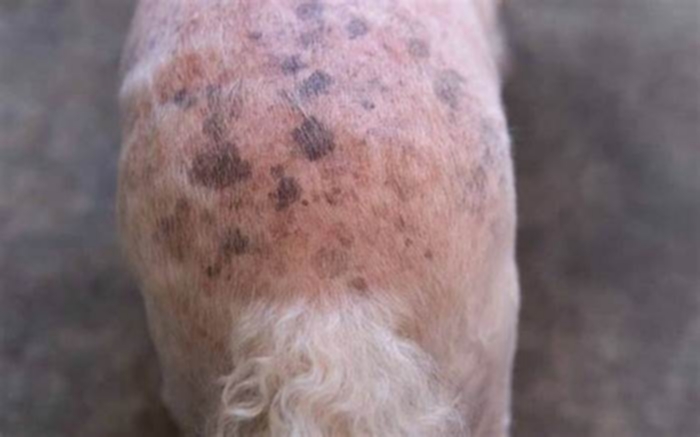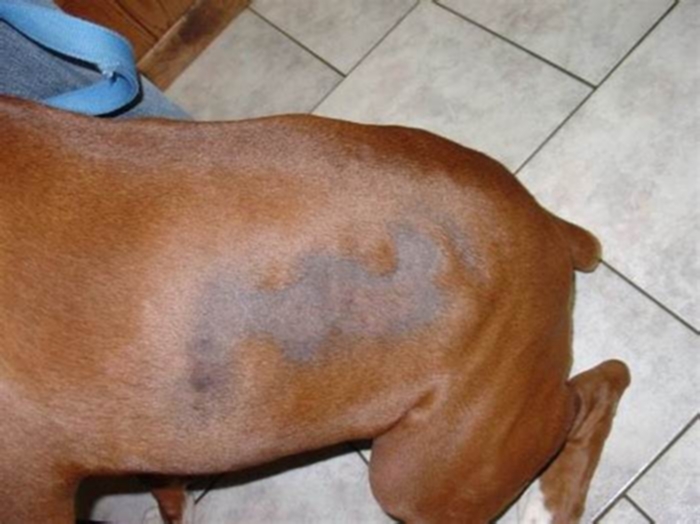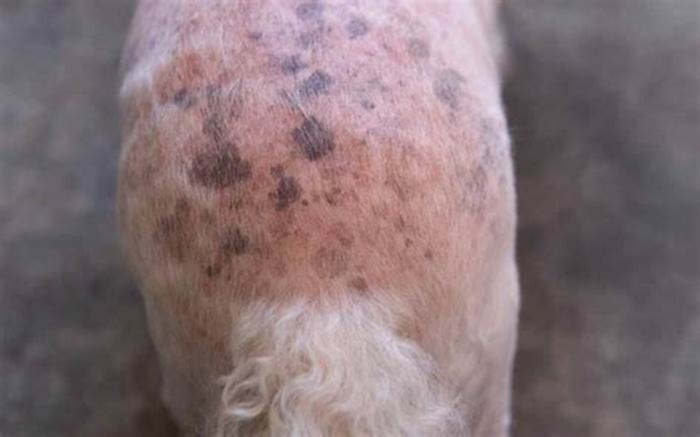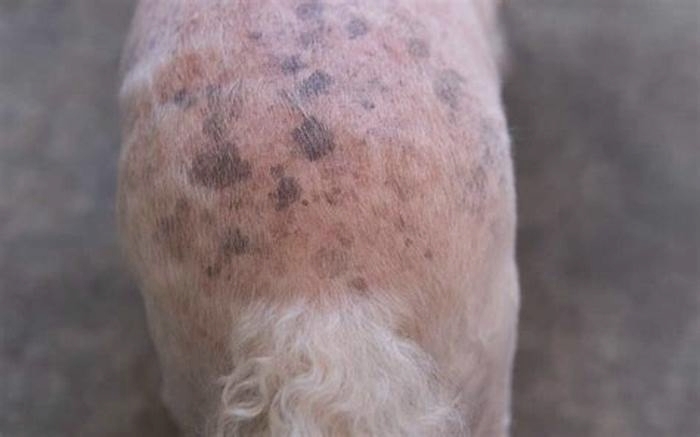Can dogs have black fungus

Treating Dog Paws with Fungal Infections [Vet Advice]
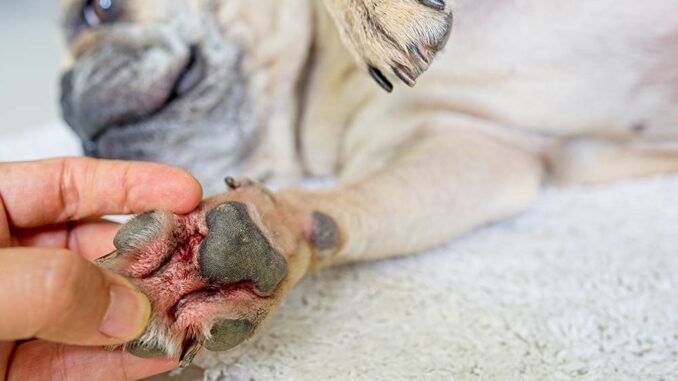
This article was updated on August 6th, 2023
Managing fungal infections on your dogs paws can be a difficult endeavor. As a practicing veterinarian, Ive seen first-hand how stubborn these fungal infections can be. Early recognition of symptoms and swift action is essential to prevent complications.
In this article Ill teach owners how to identify fungal infections in your dogs paws, how you might be able to manage them at home and how to recognize when veterinary intervention is necessary.
The goal however, is not only treating existing fungal infections but also preventing them from recurring in the future by maintaining a healthy dogs coat and body condition Ill provide some helpful insights into how to do this.
Symptoms of Fungal Infections in Dog Paws
Fungi thrive in warm, moist environments, making your dogs paws one of the most common areas that can develop a fungal infection.Common signs include:
- Itchy paws & licking or chewing at feet excessively
- Brownish-red discoloration between toes and paw pads
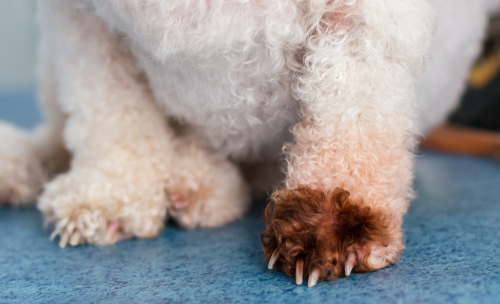
- Foul odor coming from the paws
- Crusty skin
- Hair loss on and around the infected area, as shown on the picture below:
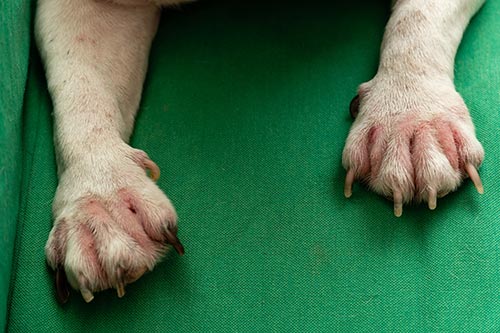
- Inflammation, redness, swelling
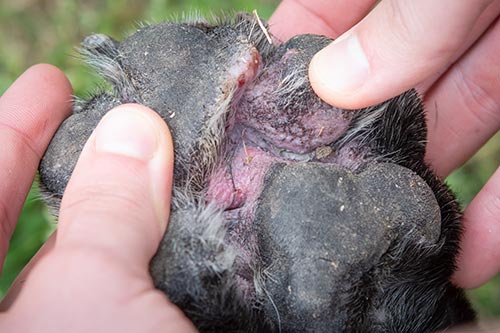
If left untreated, these symptoms can worsen over time leading to painful sores and difficulty walking. Its essential to catch these infections early before they become more severe. Click here to view more pictures of fungal infections in dogs.
Home Remedies for Managing Paw Fungal Infections
If your pooch is dealing with a pesky paw fungal infection, dont fret. There are home treatments you can try before going to the vet:
Antifungal Shampoo
An alternate approach to treating fungal infections is the use of antifungal shampoos or ointments available over-the-counter. Miconazole Nitrate Antifungal Shampoo is a great option that has proven to be effective in treating such infections. However, this might not be enough for moderate to severe fungal infections.
Natural Remedies
You could also consider natural remedies like apple cider vinegar soaks and coconut oil applications. These have antimicrobial properties that may help combat the fungus causing the infection. Keep in mind that, in my experience, these remedies may only offer short-term relief and not completely remove the infection.
Hygiene Practices
Proper hygiene practices are essential in preventing further spread of the infection. Washing the paws of your dog with a mild detergent and lukewarm water regularly will help keep them free from any hazardous fungi. You can also try disinfectant wipes such as these ones (Amazon link).
Clean Living Environment
Last but not least, ensure your pets living environment is kept clean and dry fungi thrive in damp and dirty conditions. Check out these tips on how to clean your dogs bed to keep their sleeping area spick and span.
Remember, if your dogs paw infection persists or worsens, its always best to consult with your veterinarian.
Veterinary Treatment Options
If your pups paw fungal infection doesnt clear up with the home remedies mentioned above, then its time to call your vet. They can prescribe stronger antifungal medications, either oral or topical, that are specifically designed for dogs. Fungal infections often require long courses of treatment so dont be shocked if your vet recommends 1-2 month courses of antifungal medication.
As a veterinarian, I also often recommend preventive measures such as: regular foot hygiene and avoiding areas known for fungus growth (for example: damp places or public parks with poor sanitation).
Remember that each dog responds differently to treatments due to factors like breed, age, overall health status, etc. So, always follow your vets advice regarding treatment plans and duration of therapy.
How long will it take for a fungal infection on a dogs paw to be cured?
The healing period may vary, depending on the intensity of the infection and any treatments employed. Typically, it may take several weeks or even months for complete healing.
To prevent fungal infections from recurring, it is important to treat the underlying cause
Dogs can develop fungal infections in their paws due to a variety of reasons including allergies, poor nutrition or poor hygiene. Understanding these underlying causes is crucial for effective treatment and prevention.
Lets go through the most likely causes:
Allergies
Over 10% of dogs suffer from allergies. Allergic reactions to food, environmental factors such as pollen or dust mites, and flea bites can weaken your dogs immune system, making them more susceptible to developing infections in their paws.
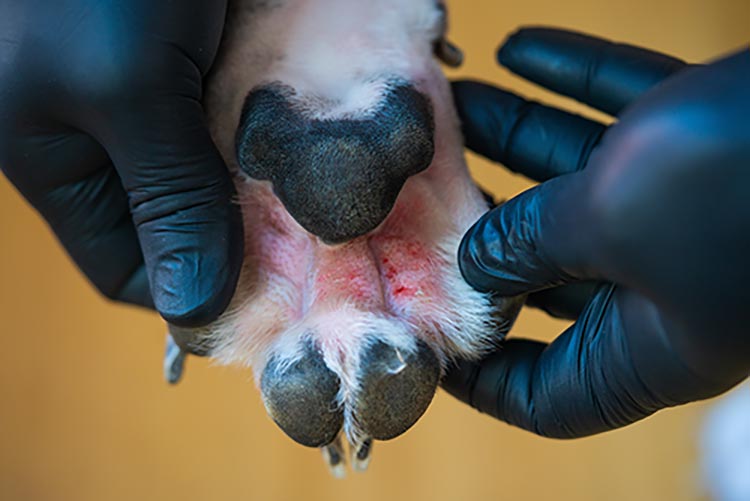
To tell if a dog has allergies, look for symptoms such as excessive itching, skin redness, ear infections, sneezing, watery eyes, and frequent licking or chewing of paws. Here is an article from the American Kennel Club that can help you identify if your dog has allergies and what treatments are available.
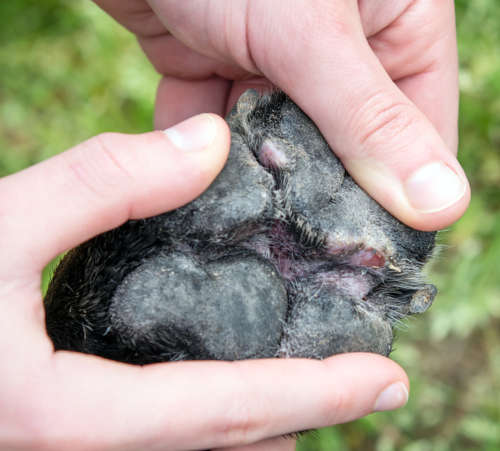
Poor nutrition
A poor diet lacking essential nutrients weakens the immune system of dogs, leading to skin problems like dermatitis, which increases the risk of paw fungus infection. Feeding your dog high-quality foods rich in vitamins A, C & E helps boost immunity against diseases.
Poor hygiene
Failing to keep up good hygiene practices by not cleaning your dogs paws regularly after walks or leaving wet feet unattended creates favorable conditions for fungi growth. Here are some tips on keeping your dogs paws clean:
- Clean your dogs feet using warm water, then dry them thoroughly, especially between toes.
- If necessary, use anti-fungal shampoo recommended by a vet.
- Regularly trim your dogs nails to prevent dirt and debris from getting trapped between the toes.
Hormonal conditions
Dogs with underlying hormonal conditions like Cushings disease, hypothyroidism, or diabetes have weakened immune systems that make them more susceptible to fungal infections.
If you suspect any of these medical conditions in your pet, it is essential to consult a veterinarian for proper diagnosis and treatment.
Diagnosis at the vet
The treatment for fungal infections is very different from other conditions, therefore accurate diagnosis is essential in getting your dog on the right treatment plan. Here is how your vet can diagnose fungal infections in your dogs paws:
Physical Examination
First, your vet will give your dogs paw a good once-over. Theyll inspect for any indications of inflammation, puffiness, irritation, or alteration in color. These are all common symptoms of a fungal infection. Read our veterinarian article with example pictures of fungal infections in dogs.
Diagnostic Tests
Many conditions can cause the symptoms mentioned above however, so often your vet will need to do some more tests. Your vet may use a special UV light called a woods lamp to inspect your dogs paws some species of fungi such as ringworm will glow under this light. A skin scraping test can also help identify any fungi present on the surface of your pets skin. In addition, a small sample of your dogs fur can be cultured to help identify the specific fungus causing the infection.
Further Testing
If the initial tests dont provide a clear answer, your vet may need to take a tissue sample for biopsy or histopathology. This is generally done under anaesthetic and will provide detailed information about infectious agents causing the infection.
Remember, accurate diagnosis is key to getting your pup back to their happy, healthy self. If you think your pup has a fungal infection, be sure to contact your veterinarian right away.
Frequently Asked Questions
Are dog paw fungal infections contagious to humans?
Its rare, but some types of fungi can potentially spread from pets to people, especially in those with weakened immune systems. Good hygiene around your dog is essential always wear gloves when handling an area on your dog affected by fungal infection.
Are dog paw fungal infections painful?
Yes, fungal infections are often painful. They can cause discomfort and distress in dogs due to symptoms like itching and swelling.
Can OTC ointments be employed to cure canine paw ailments?
While some OTC fungal creams might help alleviate symptoms temporarily and even treat mild infections, they may not effectively treat the underlying cause. Always consult a veterinarian if your dogs fungal infection doesnt improve or keeps coming back.
Alex Crow, VetMed MRCVS, is an RCVS accredited Veterinary surgeon with special interests in neurology and soft tissue surgery. Dr Crow is currently practicing at Buttercross Veterinary Center in England. He earned his degree in veterinary medicine in 2019 from the Royal Veterinary College (one of the top 3 vet schools in the world) and has more than three years of experience practicing as a small animal veterinarian (dogs and cats).
View all posts
Disclaimer: This website's content is not a substitute for veterinary care. Always consult with your veterinarian for healthcare decisions. Read More.
Identifying and Treating Fungal Infections in Dogs
By Reyna Gobel
Bacteria and viruses are what typically spring to mind hen pet parents think infection, but fungi can also be to blame. While not as common as bacterial or viral infections, fungal infections can be just as serious. Dogs can contract fungal infections from other animals, from the environment, or as a result of the overgrowth of fungi that are naturally present on their own bodies. Every pet is potentially at risk for contracting a fungal infection, and an accurate diagnosis is necessary before appropriate treatment can begin. Read on to learn more about fungal infections in dogs.
Fungal Skin Infections
When your dog starts scratching himself more than is normal, it can be hard to tell whether its because of an allergy, flea bites, infection, or something else. Excessive itching can be quite worrisome, especially if your dog develops bald spots or damages his own skin as a result.
One telltale sign of fleas is the presence of flea dirt (small black clumps of flea feces) on your dogs skin and fur. If you see flea dirt or actual fleas, treat him right away. But if fleas or ticks arent to blame, dont self-diagnose or rely on Dr. Google, warns Dr. John DaJong, a veterinarian at Newton Animal Hospital in Massachusetts. After performing a complete physical exam, your veterinarian can conduct specific tests to help diagnose the problem and identify whether a fungal infection is to blame.
Lets look at two common types of fungal infections that affect the skin of dogs and how to treat them.
Ringworm
Ringworm is a common fungal infection in pets. It can affect a dogs skin, fur, and also the nails. Common symptoms include hair loss, itching, flaky or crusty skin, and misshapen or brittle nails. While you should treat any infection as soon as possible, time is of the essence with ringworm because it can easily spread to other household animals and humans, says Dr. Andrew Rosenberg, a veterinarian at Riverdale Veterinary Dermatology clinic in Riverdale, New Jersey.
To diagnose ringworm, your veterinarian will perform a fungal culture of hair or skin cells or a microscopic examination of a hair sample. Depending on the severity of the infection, ringworm may be treated with medicated baths and dips and/or oral antifungal medications. Vacuuming and disinfecting the house will also help lessen the chances that ringworm will spread between pets and people.
Yeast Infection
Overgrowth of yeast on a dogs body can lead to irritating yeast infections, commonly affecting the skin, paws, and ears. These infections can be extremely uncomfortable for dogs, says Rosenberg. Theyre generally secondary to allergies or other conditions that disrupt the skins ability to control the yeast that normally live there.
If I suspect a dog might have a yeast infection, I take an impression smear of the area that might be infected and look at it under a microscope, Rosenberg says. When the slide is stained, the yeast look like little purple peanuts.
Treatment normally involves an antiseptic or antifungal drug applied to the skin. Oral medications may be necessary in severe cases. Unlike ringworm, yeast infections arent contagious to other pets or people. To prevent yeast infections from recurring, its important to treat any underlying conditions as recommended by your veterinarian.
If your pet is constantly itching and scratching, schedule an appointment with your veterinarian. Unfortunately, not all conditions can be solved with one visit. Sometimes it could take several visits to pinpoint the cause of your dogs itching or require a visit to a veterinary dermatologist, Rosenberg says.
Systemic Fungal Infections
Fungal infections on the surface of the body are bad enough, but those that invade deeper structures can have even more serious consequences. Lets look at several common types of systemic fungal infections in dogs and how to treat them.
Blastomycosis
Blastomycosis is most commonly diagnosed in dogs that have spent time in Mississippi, Ohio, Missouri, Tennessee, the St. Lawrence River valley, the mid-Atlantic, and around the Great Lakes because the types of soil that are typically found in these areas support the growth of the fungus. Dogs that spend time sniffing around in the dirt are at risk for inhaling fungal spores, which can lead to a lung infection, says Dr. Jennifer Coates, veterinarian and author of Dictionary of Veterinary Terms, Vet-Speak Deciphered for the Non-Veterinarian. From there, the organism can travel almost anywhere in the body. According to Coates, common symptoms include poor appetite, weight loss, coughing, difficulty breathing, limping, eye problems, skin lesions (particularly around the toenails), enlarged lymph nodes, and fever. If the disease is caught early enough, treatment with an oral anti-fungal medication can be curative.
Cryptococcosis
While cats are more commonly infected with the fungus Cryptococcus, Coates says dogs tend to develop a more severe form of the disease. The fungus is present in soils world-wide but may be especially prevalent in areas where pigeons and other birds congregate. As is the case with blastomycosis, dogs typically inhale the Cryptococcus fungus, leading to a lung infection. It can then spread almost anywhere in the body, which can cause symptoms ranging from lethargy, coughing, nasal discharge, eye problems, skin lesions, and even seizures and other neurologic abnormalities. Coates warns that treating cryptococosis can be difficult. Oral antifungal medications may need to be given for a year or more and some dogs will still succumb to the disease.
Coccidioidomycosis
Dogs can get coccidioidomycosis (also known as Valley Fever) from inhaling dust or dirt that contains coccidioides fungal spores,says Dr. Carol Hillhouse, a veterinarian in Panhandle, Texas. It tends to grow in desert areas with little rain and sandy soil, such as California, Nevada, Arizona, New Mexico, and Texas, she says. Strong winds, earthquakes, construction areas, and even crop harvesting can stir up the spores into the air.
Once the spores are inhaled, the fungus may simply cause a chronic cough, Hillhouse says. In other cases, especially if immunosuppressed, the dog may develop pneumonia or the fungus can spread to other areas in the body, such as bone or the eyes, she says. It can be difficult to diagnose, and usually requires radiographs, blood, and cell testing. Valley fever requires long-term treatment with oral antifungal medications, but the prognosis is pretty good if caught early, she says.
Histoplasmosis
Another soil-borne fungus, Histoplasma, prefers the temperate climates of Ohio, Mississippi, and Missouri River Valleys, Hillhouse says. This fungus grows best in nitrogen-rich soil, such as bird and bat excrement, and is usually acquired by inhalation of the organism from the environment.Infected dogs can show weight loss, fever, cough, eye inflammation, vomiting, and diarrhea, she says. Often, a combination of blood and urine tests, as well as radiographs, are used to make the diagnosis. Sometimes biopsies are required as well. Treatment involves long-term fungal medication, but prevention is best by restricting access to soil that is contaminated with bird or bat droppings.
Aspergillosis
Infections with Aspergillusfungus are usually limited to a dogs nasal passages. Aspergillosis can affect dogs residing in almost any part of the country since the fungus is present in most soils. Treatment typically involves anesthetizing the pet and infusing his nasal passages with a liquid anti-fungal medication. Most dogs will recover if treated appropriately, although a second treatment may be necessary in some cases.
Preventing Fungal Infections in Dogs
Fungal infections in dogs range from localized annoyances to potentially fatal systemic diseases. Prevention is not always possible, but common sense measures can help. If you live in an area where a certain type of fungal infection is endemic, avoid high risk environments. Pets with ringworm should be isolated to limit the spread of the disease to people or other animals. Finally, appropriately manage any underlying health problems that increase your dogs risk for developing a fungal infection.

